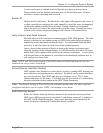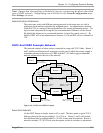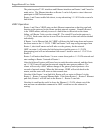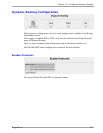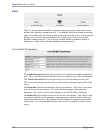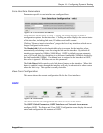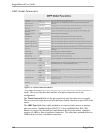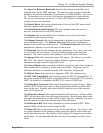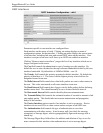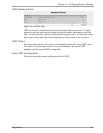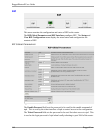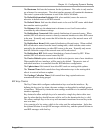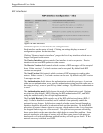
Chapter 16 - Configuring Dynamic Routing
The Auto Cost Reference Bandwidth field sets the reference bandwidth used to
calculate auto costs for OSPF interfaces. The auto cost is the reference bandwidth
divided by the interface bandwidth. By default this is 100Mbit/10Mbit = auto cost of
10. The interface cost is set in the Core Interface configuration for each interface.
The cost for each interface can also be set in the OSPF Interface configuration to
override the auto cost calculation.
The Default Metric field sets the default metric to be used for OSPF routes which
don't have another metric specified.
The Default-Information Originate field, when enabled, causes the router to
advertise its default route to the OSPF network.
The Distance field sets the administrative distance to use for all routes unless
overridden by other distance settings.
The Distance External field sets the administrative distance to use for all external
routes (backbone routes). The Distance Inter-area field sets the administrative
distance to use for all routes between areas. The Distance Intra-area field sets the
administrative distance to use for all routes within an area.
The Hostname field sets the hostname for the ospf daemon. This value is only used
as a a reference for convenience. The telnet interface prompt will contain this
hostname. The router's system wide hostname is used if this field is left blank.
The Opaque LSA field controls the opaque LSA option. This feature is covered in
RFC2370. This feature is sometimes used to distribute application specific
information through a network using OSPF LSAs.
The Passive Default option controls the default active/passive state of new interfaces.
When enabled all new interfaces will be passive by default. The passive state of
individual interfaces is controlled from the OSPF Interfaces configuration.
The Refresh Timer field controls how frequently OSPF LSA refreshes occur.
The RFC 1583 Compatibility field controls support for RFC1583 compatibility. If
this option is enabled OSPF will be compatible with the obsolete RFC1583 version of
OSPF. By default it is compatible with RFC2178 version of OSPF only.
The Redistribute Connected fields control distribution of connected routes. When
enabled, OSPF will advertise routes to directly connected interfaces to other OSPF
routers in the area. Normally only routes that fall within the scope of the network
areas will be advertised.
The Redistribute Kernel fields control distribution of kernel routes. When enabled,
OSPF will advertise routes from the kernel routing table, which includes static routes
entered by the administrator, to other OSPF routers in the area. Normally only routes
that fall within the scope of the network areas will be advertised.
The Redistribute RIP fields control distribution of routes learned by RIP. When
enabled, OSPF will advertise routes learned by RIP.
The Router Id field sets the router-id to use for the ospf daemon. This value is used
as a unique identifier for the dynamic routing protocol to identify which router sent
which route advertisement. By default it uses the highest IP assigned to an interface
on the router. It is recommended that this value be set to a unique fixed IP on each
router.
RuggedCom 161



